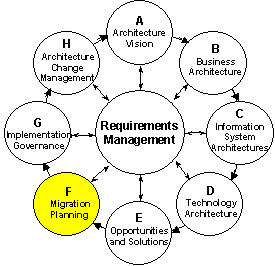 Objective
ObjectiveObjective Approach Inputs Steps Outputs
 Objective
ObjectiveThe objective of this phase is to sort the various implementation projects into priority order. Activities include assessing the dependencies, costs and benefits of the various migration projects. The prioritized list of projects will go on to form the basis of the detailed implementation and migration plan.
There are some important questions to be asked before embarking on a migration exercise:
Many things affect the answers to these questions, including the current and future architectures, the size of the organization and its complexity, and the value of technology to the core functions of the organization. Other things to consider are the asset value of the current systems, and the level of risk associated with changing the solution and/or the supplier.
Most organizations find that a change of architecture has too much impact on the organization to be undertaken in a single phase. Migration often requires consideration of a number of technical issues, not the least of which are those associated with the means of introducing change to operational systems.
Issues requiring special consideration may include:
The decisions resulting from these considerations should be incorporated in the implementation plan.
There are a number of strategies for developing the migration and implementation plan.
The most successful basic strategy is to focus on projects that will deliver short-term pay-offs and so create an impetus for proceeding with longer-term projects.
One common approach is to implement business functions in a data-driven chronological sequence: i.e, create the applications and supporting technology that create data before those that process the data, before those that simply store, archive or delete data.
For example, the following detailed description of this approach is taken from: SPE 68794, "Implementing Enterprise Architecture - Putting Quality Information in the Hands of Oil and Gas Knowledge Workers", G. A. Cox, R. M. Johnston, SPE, and R. M. Palermo, Aera Energy LLC, Copyright 2001, Society of Petroleum Engineers Inc.
The current system disposition decisions should be made by business people, not IT people.
Applications should be combined or split into parts to facilitate sequencing and implementation. This rearrangement of applications creates a number of projects, a project being equivalent to an application or to combinations or parts of applications.
Develop the data sequence for the projects as described in the data architecture. Using the CRUD (Create / Read / Update / Delete) matrix developed as part of the Data Architecture, sequence the projects such that projects that create data precede projects that read or update that data.
Develop an estimated value to the business for each project. To do
this, first develop a matrix based
on a value index dimension and a risk index dimension. The value index includes the
following criteria: principles compliance, which includes financial contribution,
strategic alignment, and competitive position. The risk index includes the following
criteria: size and complexity, technology, organizational capacity, and impact of a
failure. Each of the criteria has an individual weight. The index and its criteria and
weighting are developed and approved by senior management early in the project. It is
important to establish the decision-making criteria before the options are known.
In addition, there will be key business drivers to be addressed that will also tend to dictate the sequence of implementation, such as:
Another, possibly complementary, approach is for the individual projects or work packages to be group-sorted into a series of plateaus, each of which can be achieved in a realistic time scale.
The following description assumes a Target Architecture with only a single time horizon.
Inputs to this phase are:
Key steps in this phase include:
The output of this phase is:
Copyright © The Open Group, 1998, 1999, 2000, 2002, 2003